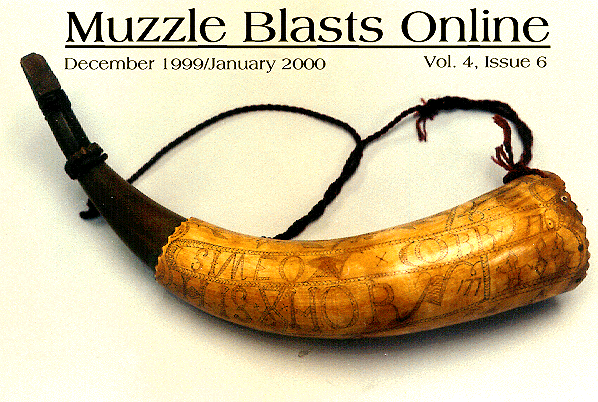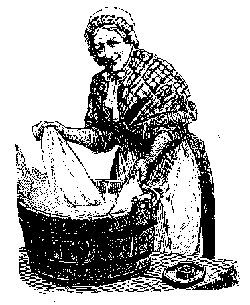|
Muzzle Blasts Online |
|
...for the muzzleloading enthusiast |
|
The muzzleblasts.com domain, subdomains, content, etc., are neither affiliated with the NMLRA nor its paper magazine Muzzle Blasts |
|
Muzzle Blasts Online |

|
|
|
|
|
|
How To Make Soap

|
The old folks made their own, for reasons of finance and availability. Most made soap once a year, after killing hogs or beef, when a good supply of fat was available.
During the Great Depression, animal fats were hard to find in quantity. One commercial soap manufacturer tried making soap out of used motor oil. The result was detergent. It was found that detergent rinses away faster than soap. This meant an easier clothes washing day, "whiter whites," and brighter colors than from soap. Soap, being harder to rinse out of clothing, left a residue that caused whites to darken and colors to appear dull.
Most bar "soap" that you purchase today is bar detergent. It rinses away from your skin easily. Most of the natural glycerin, however, has been removed to sell separately, and you are left to bathe with a product that leaves you with dry, cracked skin.
Home made soap, made the old way, will actually cure many of the dry skin problems that people experience. The old folks had many home remedies that worked on the principles of modern pharmaceutical products. For instance, make a thick lather paste of home made soap and apply to poison ivy, let it dry, and wash it off twice a day. Reapply for three days; it works! It stops the itching while preventing the liquid from poison ivy blisters from spreading the rash.
Lye soap, contrary to what you may have heard, is very mild and makes good lather. It is an excellent skin conditioner. You haven't actually ever felt as clean as you will after a bath with homemade soap. The lye leeches out and dissipates during the curing time allotted.
Let's Make Some Soap!
Before we list the recipe that I use, let's look at the components used by the pioneers. Three ingredients
went into the mix that became soap: lye, water, and lard or tallow. The lye was made rather than bought. We
must remember that money was an item that for most folks was in short supply. If they had any, it was used
only to buy essential items that could not be gathered, shot, or hand made.
To make lye, a wooden box or barrel was filled with hardwood ashes, preferably oak ashes. Rain water was allowed to leach through the ashes and soak for an undetermined amount of time. The lye water produced in this manner was said to be strong enough only when it would float an egg.
Ashes mixed with just enough water to make a paste was used as silver or brass polish. Ashes were also thrown into the boiling water to help loosen hair on a hog before it was scraped to remove the hair during butchering.
Lard or tallow was produced by rendering the fat from hog or beef. Hog fat was cut into chunks maybe two inches square and dumped into a cast iron kettle. This was done outside in the winter when the fire under the kettle was enjoyable to stand by. As the fat is heated, it produces melted lard, which in fact cooks by deep frying all the fat left after it yields the lard. When these small pieces turn crispy brown, they are ready to dip out and are wonderful to eat. Called "cracklin's," they are sweet and crunchy. A few peeled whole potatoes thrown into the bubbling lard will deep fry and be ready to eat as a real treat with your cracklins. After dipping everything out, only melted lard is left. This is allowed to cool and solidify. If you didn't burn the cracklins, the lard will be a good milky white color. Then dip it out and put into containers for later use. Remember that absolutely nothing was wasted. You have not only made about four gallons of lard from a 200-pound hog, but also cooked lunch and fed your family from the same pot. The remainder of the cracklins are used as an additive to the cornbread mix. You haven't lived until you have eaten hot cracklin cornbread with fresh homemade butter.
It was not common to find an individual soap maker who could consistently make one good batch of soap after another. Most did not have thermometers and timers, which are important to use for consistency in soap hardness, texture, color, and smell.
I will give you an example of what was used in lieu of a thermometer. On a seventeen-degree morning, outside, water needs to be between 170 and 180 degrees F to scald a hog so that the hair will slip. Any cooler, it won't slip, and any hotter, it will begin to cook the meat. When asked if the water was hot enough, my friend Grumpy Dwight Hillenburg told me to dip my hand in the water, and if the hair on the back of my hand would rub off it was hot enough! The cooking thermometer I refer to in the following paragraphs is a far better indicator.
Dwight and Richard Andrews came to Arkansas from Indiana just to help me make a video on how to kill hogs the old way. They are two fine gentlemen I met at Friendship during the national shoots. Both will do to ride the river with.
Now to the recipe
Supplies needed for a batch to make approximately 110 bars of standard size soap are as follows:
- one pair safety glasses, one pair rubber gloves, one cooking thermometer, one watch, one ceramic-coated eight-gallon metal container, one five-gallon plastic bucket, one canoe paddle or handmade wooden stirring paddle, one set of scales that will weigh up to nineteen pounds.
- 2 lbs. 8 oz. of coconut oil
- 2 lbs. 8 oz. of blended vegetable oil
- Important Note: All ounces are by weight-not volume
- 19 lbs. of lard
- 3 lbs. 8 oz. of lye crystals (Red Devil)
- 10 lbs. 4 oz. of water
- Assorted small plastic molds (I had 200 soap molds made for me, but you can use small plastic or vinyl food containers, detergent scoops, etc.) Do not use metal molds as the lye will eat through them.
If you wish to make the old soap recipe, delete the coconut oil and the vegetable oil and add five lbs. of lard, making a total of 24 lbs. of lard. The coconut oil produces a very fine, small-bubbled lather. The vegetable oil helps the soap to rinse away easily. If you wish, you may make a half-batch or a quarter-batch.
Important note: Weigh each item carefully.
Directions: Put on the glasses and gloves. Keep them on until your soap is poured in the molds. One crystal of lye on a sweat droplet on your arm will burn a big hole in your skin! Do this project outside!
Place the weighed water into the plastic bucket. Then add the lye crystals and stir with the wooden paddle; don't splash any onto yourself. Stir until all crystals dissolve. Never pour water onto lye crystals; always add the crystals to the water. As you add and stir the crystals, the water will instantly react by becoming hot, well over 200 degrees. Don't stick your finger into it. It will take the lye water a while to cool. You want to cool it to 100 degrees and then pour it into the melted lard mixture. While the lye water is cooling, heat the ceramic-coated metal pot containing the lard and the coconut and vegetable oils. Heat till all is liquid. Take from the fire and let it cool to 100 degrees. Both the lye and lard mixture need to be 100 degrees before mixing together. (You may have to heat one or the other to achieve even temperatures.) It's kind of like getting biscuits and gravy to disappear from your plate at the same time.
When both components are at 100 degrees, pour the lye water slowly into the ceramic-coated container containing the lard mixture. You must continually stir to keep the mixture from separating, as fat naturally floats on water. The lye water chemically reacts with the lard and oils to produce a salt that we call soap.
Stir for forty minutes. I cheat by using an electric drill fitted with a piece of hickory dowel with a cross-shaped paddle attached.
Three minutes before you quit stirring, you may wish to add a potpourri oil concentrate, three ounces by volume, to the batch to make it smell nice. Do not add the scent earlier, because the lye will "eat it up" and nullify the scent.
After the forty minutes, pour into molds. Let molds sit on tables in a seventy-degree room for two days. At this time, try dumping a bar of soap from one of the molds. If it comes out in one good semi-firm piece, then dump all the molds onto a table that has been covered with waxed paper. If the humidity is high, this may take three days. Place 3" x 1/4" wooden dowels so that two dowels are parallel and three inches apart on the table. Place bars of soap on the dowels so that the bars rest on the dowels instead of on the table. This allows the air to get to all sides of the soap. Now let the soap cure for sixty days. This curing time allows the lye to dissipate; then you may take a bath.
If you wish to wash clothes with your soap, then you should use a knife to shave small flakes of soap from the bars. Some folks reading this will remember the modern "Ivory Flakes" brand laundry soap sold in stores years ago.
Doing things the old way like making your own soap is cheaper, better, and more enjoyable than going to the store.
Here's to the old ways.